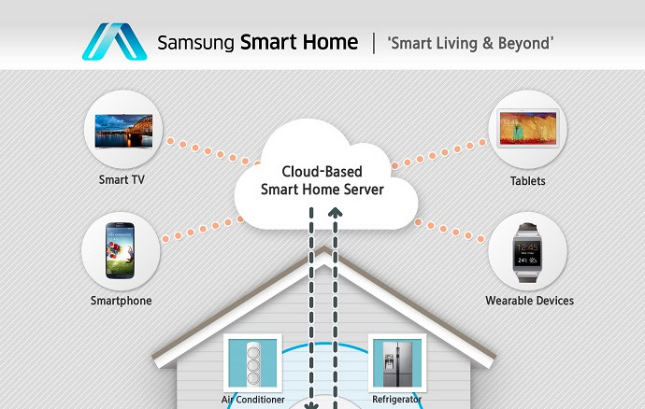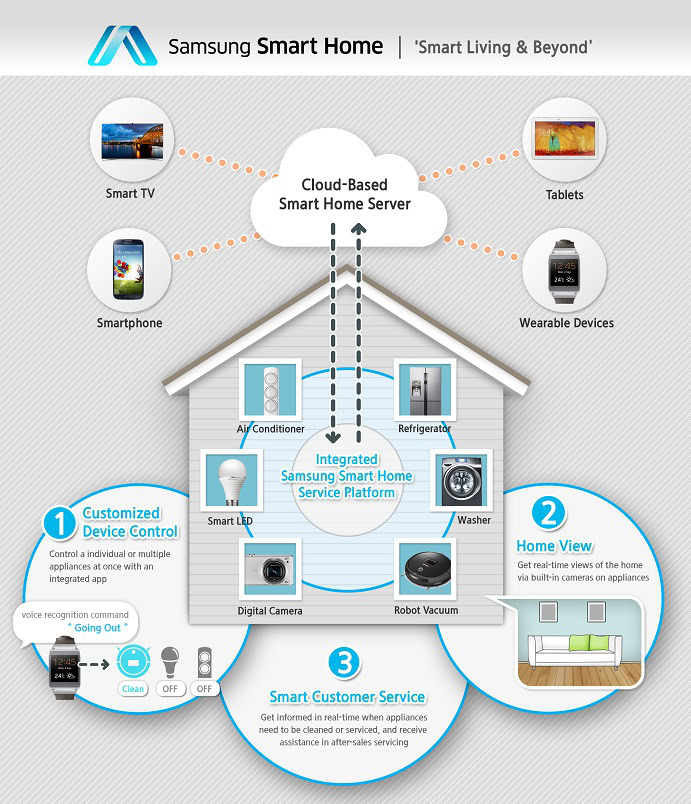Affiliate links on Android Authority may earn us a commission. Learn more.
Samsung Smart Home relies on Android to connect your home, company doesn’t acknowledge the OS
Published onJanuary 5, 2014

Samsung on Sunday made a surprise pre CES 2014 announcement: Smart Home project that plans to connect all the smart devices in your home, including mobile devices, a service that seems to rely heavily on Android to work, at least at the beginning. Strangely, though Android is not mentioned anywhere in the official press release.
As you can see in the diagram below, Samsung wants to push home-related notifications to your smartphone, tablet, wearable devices and Smart TV, although three of these devices require Android to run. Sure, Samsung also sells Windows Phone devices and is working on launching its Tizen platform, but the mobile products it advertises are all based on Android. In fact, the Galaxy Gear gets named twice, while the Galaxy S4 and Galaxy Note 10.1 (2014 Edition) can also be easily recognized in the image.
The Smart Home service will roll out commercially in the first half of 2014, at which point users will be able to better monitor and manage their home from their mobile device, assuming of course they purchase compatible connected appliances – they’ll have to be Samsung-made products to connect to the company’s Smart Home, at least at the beginning. In time, other mobile devices and appliances from the competition will be supported.
Initially, the Smart Home will offer three features for its apps including Device Control, Home View and Smart Customer Service (see following image).

With Device Control, users will be able to customize settings on their mobile devices or Smart TVs with the purpose of controlling the home appliances. That includes turning on and off devices while in the house but also while away. Support for voice-based commands will be included as well:
Smart Home also offers a voice command function on all the controller devices. If a user says ‘going out’ to his GALAXY Gear device, home lighting and selected appliances are turned off. If the user says ‘good night’ to their Smart TV remote control, the TV will be turned off and lights dimmed and gradually turned off in readiness for sleep. Users can also use chat control on their smartphone app as a fun, convenient way to communicate with their devices.
With Home View, users will be able to remotely turn on the devices in their home that have a camera, and see what’s happening in their homes on the screen of their mobile devices. The Smart Customer Service will notify users when it’s time to service appliances or to replace consumables.
Finally, a Smart Home software protocol has been developed to enable connectivity between all these devices. Future Smart Home plans are related to other services including home-energy, secure home access, healthcare and eco home applications.
In addition to Samsung, LG also has unveiled a home managing system for mobile devices called HomeChat. LG’s method relies on a text-messaging-like interface for Android, iOS and Windows Phone devices – interestingly LG did mention Android in its official press release in late December.
[press]
Summary:
Samsung Smart Home, a service enabling users to control and manage their home devices through a single application, will be unveiled at CES 2014.
The three main service features of Samsung Smart Home are Device Control, Home View and Smart Customer Service.
Samsung has also developed a dedicated Smart Home software protocol (SHP) to enable connectivity between all Samsung Smart Home products as well as those from other device and appliance manufacturers.
Samsung Unveils New Era of Smart Home at CES 2014
Samsung Smart Home enables home devices connectivity through a single integrated platform; provides foundation for emerging ecosystem of connected home services
Samsung Electronics announced Samsung Smart Home, a service enabling Smart TVs, home appliances and smartphones to be connected and managed through a single integrated platform.
The Samsung Smart Home brand and product logo will debut at CES 2014 in Las Vegas, and the service will be commercially rolled out across Samsung devices and appliances in the first half of 2014. Pursuing its vision for a connected world, Samsung will also collaborate with third-party partners to make the Smart Home service extendible to their products and services, building the foundation for a rapidly-growing ecosystem of connected home services.
“With Samsung Smart Home, we are bringing our capabilities as the world’s number-one manufacturer of smart devices to make the connected home a reality for consumers today,” said Wonpyo Hong, President, Media Solutions Center, Samsung Electronics. “In the coming days, we will continue to roll out better home services to our consumers to enable them to keep enjoying a brand-new experience of ‘Smart Living and Beyond’.”
Samsung Smart Home’s unique functionality enables users to control and manage their home devices through a single application by connecting personal and home devices—from refrigerators and washing machines to Smart TVs, digital cameras, smartphones and even the wearable device GALAXY Gear—through an integrated platform and server.
Samsung Smart Home will initially provide three main service features enabling users to connect with their devices from anywhere, anytime: Device Control, Home View and Smart Customer Service.
With Device Control, users can use customized settings on their mobile devices or Smart TV to monitor or control home devices —turning on air conditioning or activating lighting, for example—while inside or outside the home, or even while travelling abroad. At the touch of a dedicated Smart Home app icon on their device, the service enables users to control one or multiple devices simultaneously no matter where they are.
Smart Home also offers a voice command function on all the controller devices. If a user says ‘going out’ to his GALAXY Gear device, home lighting and selected appliances are turned off. If the user says ‘good night’ to their Smart TV remote control, the TV will be turned off and lights dimmed and gradually turned off in readiness for sleep. Users can also use chat control on their smartphone app as a fun, convenient way to communicate with their devices.
With the service’s Home View feature users can also use their smartphone to get real-time views of the home via in-built appliance cameras; and Smart Home’s Smart Customer Service notifies users when it’s time to service appliances or replace consumables, and provides assistance in after-sales servicing.
Initial deployment of Samsung Smart Home will focus on a range of Samsung Smart TVs, home appliances and smartphones. The service will gradually expand its coverage by including additional Samsung products as well as other manufacturers’ devices and appliances.
Samsung has also developed a dedicated Smart Home software protocol (SHP) to enable connectivity between all Samsung Smart Home products as well as those from other device and appliance manufacturers. Through this strategy, Samsung aims to create a foundation for an emerging ecosystem of connected home services in collaboration with its partners.
Samsung also plans to expand the Smart Home service to cover home-energy, secure home access, healthcare, and eco home applications through the partnerships with third-party service providers in these sectors, helping foster joint commercial opportunities and grow the connected home service marketplace.
Led by Mr. Hong, Samsung established an internal organization in the middle of last year —called the Smart Home Steering Committee—to align all of the company’s product groups, including its R&D arm, behind the Smart Home platform and co-ordinate the development of innovative services and commercial partnerships around the service.
[/press]